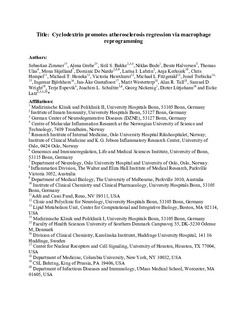| dc.contributor.author | Zimmer, Sebastian | |
| dc.contributor.author | Grebe, Alena | |
| dc.contributor.author | Bakke, Siril Skaret | |
| dc.contributor.author | Bode, Niklas | |
| dc.contributor.author | Halvorsen, Bente | |
| dc.contributor.author | Ulas, Thomas | |
| dc.contributor.author | Skjelland, Mona | |
| dc.contributor.author | De Nardo, Dominic | |
| dc.contributor.author | Labzin, Larisa I. | |
| dc.contributor.author | Kerksiek, Anja | |
| dc.contributor.author | Hempel, Chris | |
| dc.contributor.author | Heneka, Michael T. | |
| dc.contributor.author | Hawxhurst, Victoria | |
| dc.contributor.author | Fitzgerald, Michael L. | |
| dc.contributor.author | Trebicka, Jonel | |
| dc.contributor.author | Björkhem, Ingemar | |
| dc.contributor.author | Gustafsson, Jan Åke | |
| dc.contributor.author | Westerterp, Marit | |
| dc.contributor.author | Tall, Alan R. | |
| dc.contributor.author | Wright, Samuel D. | |
| dc.contributor.author | Espevik, Terje | |
| dc.contributor.author | Schultze, Joachim L. | |
| dc.contributor.author | Nickenig, Georg | |
| dc.contributor.author | Lütjohann, Dieter | |
| dc.contributor.author | Latz, Eicke | |
| dc.date.accessioned | 2018-03-06T11:32:29Z | |
| dc.date.available | 2018-03-06T11:32:29Z | |
| dc.date.created | 2016-07-12T13:16:03Z | |
| dc.date.issued | 2016 | |
| dc.identifier.issn | 1946-6234 | |
| dc.identifier.uri | http://hdl.handle.net/11250/2488863 | |
| dc.description.abstract | Atherosclerosis is an inflammatory disease linked to elevated blood cholesterol concentrations. Despite ongoing advances in the prevention and treatment of atherosclerosis, cardiovascular disease remains the leading cause of death worldwide. Continuous retention of apolipoprotein B–containing lipoproteins in the subendothelial space causes a local overabundance of free cholesterol. Because cholesterol accumulation and deposition of cholesterol crystals (CCs) trigger a complex inflammatory response, we tested the efficacy of the cyclic oligosaccharide 2-hydroxypropyl-β-cyclodextrin (CD), a compound that increases cholesterol solubility in preventing and reversing atherosclerosis. We showed that CD treatment of murine atherosclerosis reduced atherosclerotic plaque size and CC load and promoted plaque regression even with a continued cholesterol-rich diet. Mechanistically, CD increased oxysterol production in both macrophages and human atherosclerotic plaques and promoted liver X receptor (LXR)–mediated transcriptional reprogramming to improve cholesterol efflux and exert anti-inflammatory effects. In vivo, this CD-mediated LXR agonism was required for the antiatherosclerotic and anti-inflammatory effects of CD as well as for augmented reverse cholesterol transport. Because CD treatment in humans is safe and CD beneficially affects key mechanisms of atherogenesis, it may therefore be used clinically to prevent or treat human atherosclerosis. | nb_NO |
| dc.language.iso | eng | nb_NO |
| dc.publisher | American Association for the Advancement of Science | nb_NO |
| dc.title | Cyclodextrin promotes atherosclerosis regression via macrophage reprogramming | nb_NO |
| dc.type | Journal article | nb_NO |
| dc.description.version | submittedVersion | nb_NO |
| dc.source.volume | 8 | nb_NO |
| dc.source.journal | Science Translational Medicine | nb_NO |
| dc.source.issue | 333 | nb_NO |
| dc.identifier.doi | 10.1126/scitranslmed.aad6100 | |
| dc.identifier.cristin | 1367729 | |
| dc.relation.project | Norges forskningsråd: 223255 | nb_NO |
| dc.description.localcode | This is a submitted manuscript of an article published by American Association for the Advancement of Science in Science Translational Medicine, 06 Apr 2016 | nb_NO |
| cristin.unitcode | 194,65,15,0 | |
| cristin.unitname | Institutt for klinisk og molekylær medisin | |
| cristin.ispublished | true | |
| cristin.fulltext | preprint | |
| cristin.qualitycode | 1 | |
